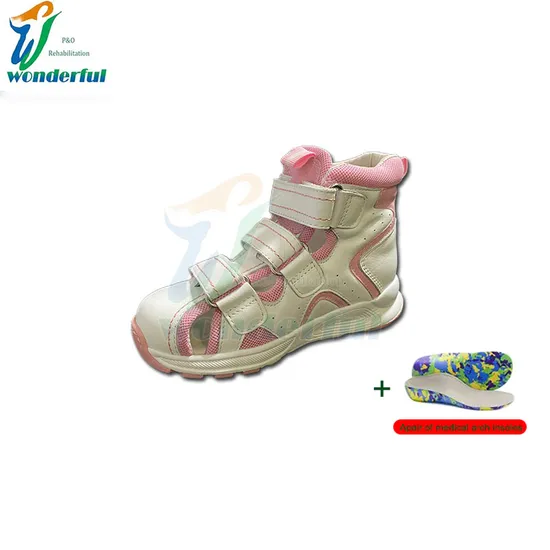
Lightweight Breathable Non-Slip Shock-Absorbing Orthopedic Shoes for Children
Basic Info.
Model NO.
PWOS
Waterproof
Not Waterproof
Close Pattern
Magic Tape
Sole Material
EVA
Element
Totem
Toe Style
Peep Toe
Gender
Unisex
Season
Summer
Stock
Stock
Applicable People
Flat Feet, X-Shaped and O-Shaped Legs
Sole Features
Non-Slip and Wear-Resistant Sole
Upper Features
Lightweight and Breathable
Advantage
Built-in 3D Insole Technology
Transport Package
Carton
Specification
Leather
Trademark
Wonderfu
Origin
China
HS Code
9021310000
Production Capacity
3500pairs /Month
Product Description
Product DetailsProduct Introduction | Orthopedic shoes (corrective shoes) are special shoes made according to a doctor's prescription to correct foot diseases for the purpose of correcting foot deformities, dispersing foot pressure and relieving pain symptoms. They are also called shoe-shaped orthotics. |
| Color | Pink and white or (as requsted) |
| Category | Children's Shoes |
| Features | Breathable; Anti-slip; Shock absorption; |
| Advantages | Lightweight, cushioned sole with ergonomic stride design can enhance stability, provide excellent shock absorption and relieve heel pain. |
| payment | T/C, T/T, Western Union, Paypal, Money Gram |
| Sample | It is available, but buyers are required to pay for shipping and customs fees. |
| MOQ | 200 Pairs Per item in multiple sizes |
| Delivery Time | 25-30 days after receipt the 30% deposit |
The function of orthopedic shoes (corrective shoes) is to enhance the foot's stress management and load relief while standing and walking. They alleviate pain, prevent deformities, and correct functional foot abnormalities. Additionally, they offer essential support for patients with permanent deformities, enabling them to achieve balance.
These shoes are suitable for treating various conditions such as inversion foot, valgus foot, equinus foot, foot drop, flat foot, arched foot, hammer foot, heel spur, subtalar joint ankylosis, ankle arthritis, hallux valgus, foot fracture, foot defect, metatarsalgia, and plantar fasciitis.
BasicFeaturesof Orthopedic Shoes
1. Pain Relief
For instance, incorporating sponge insoles, specialized heel spur pads, or creating pits in the heel area ofthe shoe can alleviate heel pain for patients suffering from heel spurs and calcaneal periostitis during walking.
2. Deformity Prevention and Correction
Orthopedic shoes correct foot deformities and improve the foot's weight-bearing alignment. For individuals with heavy weight, overload, or prolonged standing, flat foot pads and shoes can prevent the arch from collapsing.
3. Compensating for Lost Joint Movement
A wedge-shaped rubber sponge pad on the heel can minimize the impact for patients with ankle stiffness. Additionally, a rolling horizontal bar added to the forefoot of the shoe assists patients with stiff metatarsophalangeal joints in smoothly transitioning from flattening their foot to lifting off the ground while walking.
4. Eliminating Joint Activity
Using an extended sole hard plate made of elastic steel can eliminate metatarsophalangeal joint movements. This is particularly beneficial for patients with deformed and stiff metatarsophalangeal joints, reducing pain and preventing further deformities.
Classification of Orthopedic Shoes
1. By Function
These include height-compensating shoes for shortening of the lower limbs, gap-filling shoes for foot defects, and corrective shoes for foot deformities and diseases.
2. By Affected Body Part
Orthopedic shoes are categorized into high-arch shoes, foot drop shoes, toe shoes, inversion shoes, eversion shoes, bone spur shoes, flat-foot shoes, and other corrective shoes for specific foot conditions.
3. By Material
Options include leather orthopedic shoes and artificial leather orthopedic shoes.
4. By Shoe Structure
Common styles range from high waist (high top) to low waist (low top) designs.
5. By Season of Use
There are clip shoes for spring and autumn, sandals for summer, and warm shoes for winter.
More Similar Products
Appropriate Types
3D Scanning
Our Company
Shipping
>> Cee China 3.0kw Electric Start Portal Gasoline Inverter Generator
>> Automatic Tissue Paper Production Line Machine From Paper Processing to Packaging
>> LED Indoor PAR Light 4PCS 50W Warm White LED Matrix PAR Stage Light DJ Lights
>> Hot sell women rain boots,Fashion Transparent ladies boots,Transparent Lady boots,Female rain boots
>> Agricultural Garden Farm Orchard Construction Small Excavators Hydraulic Crawler Mini Compact Multi-Function Bagger Loader Backhoe Digger Excavator
>> Precio De Fumigacion Dron PARA Fumigar Pulverizador 30L Farm Spraying Uav OEM Agricultural Sprayer Pesticide Drone for Agriculture with Fertilizer Sow Spreader
>> 2-Pieces Long Sleeve Little Girls Rash Guard Swimwear
>> Multifunctional Vehicle Antenna LTE&GPS&Glonass&WiFi Antenna Combo Antenna
>> Epoxy Resin USB Micro Backup Alarm Smart Buzzer
>> Freestanding Bathtub Solid Surface Bathtub Artificial Stone Bathtub Acrylic Bathtub
>> Wholesale Customized Printing Brown Food Kraft Paper Bag Stand Up Zipper Pouch For Packaging Nuts And Dried Fruit
>> Automatic Tissue Manufacturing Line Machine with Safety Features for Exported
>> Taijia portable doppler ultrasonic flow meters manufacturer ultrasonic doppler flow meter high temperature
>> hand grip video household hand grip 200lb cheap price with sbr hand grip
>> Filter Oil Filter Air Filter Element Compressed
>> High Efficient Organic Manure Fermentation Composting Machine Automatic Crawler Type Compost Turner for Sale
>> High Efficiency Agricultural Wastes Biomass Ring Die Wood Pellet Machine
>> Cheap 2 Ton 3 Ton Mini Excavator Price CE Approved Excavator Machine Mini Excavator for Sale Small Construction Machinery Farm Mini Excavator
>> 2 in 1 Elevated Bamboo Wooden Cat Dog Bowls Stand Food Feeder for Pets Drinking Water Feeding
>> Cooling tower infill OEM high strength customized PVC 1000mm*750mm blue cooling tower fill
>> Electric Swing Door Operator Automatic Close Sw200 Slim
>> YADA Natural Customized Logo Fast Food 210mm Bamboo Twin Chopsticks Disposable Sushi Chopsticks
>> High Shear Dispersing Bitumen Emulsifier Pump
>> Hot Selling Solar Powered Rubber Neon Lights for Event Christmas
>> Full Body Polished House Apartment Hotel School Home Bathroom Kitchen Porcelain Floor Wall Tile
>> Handheld Air-Operated Crankshaft Polisher CPA Series
>> Professional factory vertical powder packaging machine spice powder packaging machine stable performance
>> Orient Inflatables Small Jungle Inflatable Dragon Slide for Sale
>> barbecue mesh Charcoal BBQ Grill
>> China Lanhao 1400mm Intelligent Folding Machine for Metal